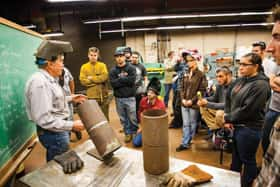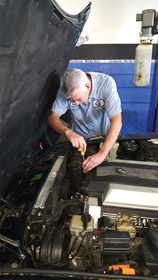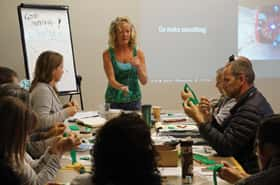In the ever-evolving world of business, middle skills are earning new respect. Once known as blue-collar jobs, hands-on positions today often require a high degree of technical expertise, and workers with that kind of knowledge, plus training relevant to the workplace, can find satisfying careers with good wages and benefits. Employees are in demand and play an essential role in the local economy, but qualified workers aren’t easy to find.
Need
 “Everyone seems to be looking for new employees; but they’re few and far between,” says Robin Bartholow, director of membership and marketing at the North Coast Builders Exchange in Santa Rosa and Chair of the Sonoma County Workforce Investment Board. She reports hearing about the lack of qualified workers from landscaping companies, large construction companies, medium-sized contractors and even small shops that need to add one or more employees. “We are now in a seasonal slow period as the weather turns inclement. But this summer and fall, everyone appeared to be in growth mode and competing for the same workers,” she says. She’s aware of some employers attempting to entice candidates from other companies by offering better salaries and benefits, and observes, “It’s has definitely been an employees’ market.”
“Everyone seems to be looking for new employees; but they’re few and far between,” says Robin Bartholow, director of membership and marketing at the North Coast Builders Exchange in Santa Rosa and Chair of the Sonoma County Workforce Investment Board. She reports hearing about the lack of qualified workers from landscaping companies, large construction companies, medium-sized contractors and even small shops that need to add one or more employees. “We are now in a seasonal slow period as the weather turns inclement. But this summer and fall, everyone appeared to be in growth mode and competing for the same workers,” she says. She’s aware of some employers attempting to entice candidates from other companies by offering better salaries and benefits, and observes, “It’s has definitely been an employees’ market.”
Rick Wells, CEO of the Marin Builders Association, often encounters employers in the building trades with a shortage of qualified workers. “We’re hearing that across the board—across the industry,” he says, adding that an aging workforce and the high cost of living in the North Bay are contributors to the dearth of prospects. And it’s not just the construction industry. The phenomenon of good jobs in middle-level positions going unfilled is occurring throughout the workplace.
“In the auto industry, we’re starving for technicians. We’ve had a very, very difficult time getting employees,” says John Bottari, owner of West Bay Bavarian in San Rafael. For skilled employees, he’ll occasionally have someone who’s unhappy with a job at another company submit a résumé, but for the most part, the type of person he sees isn’t qualified to work on high-end vehicles like the BMWs his company services.
employees,” says John Bottari, owner of West Bay Bavarian in San Rafael. For skilled employees, he’ll occasionally have someone who’s unhappy with a job at another company submit a résumé, but for the most part, the type of person he sees isn’t qualified to work on high-end vehicles like the BMWs his company services.
He offers opportunities to entry-level workers who might be interested in pursuing a career in automotive technology; for instance, he’ll take on apprentices. “If they have enough experience, I’ll link them up with my senior technician,” he says, and they can follow him around and start with simple jobs like oil changes and brake work. “If they need further training, I’m more than happy to send them to school,” he adds.
He’ll also hire high school students in the summer, and they can watch technicians and help clean up the shop to give them a taste of life in the auto world so they can decide if it’s something they’d like to pursue further. These days, though, he doesn’t see many people looking for these types of jobs. “We have an aging population, and that applies to auto technicians as well,” he says. “We need to get younger people in the pipeline for good paying jobs to continue the tradition.”
Exploration
 The first challenge is finding people who want to enter the trades, and high-school classes often spark a student’s interest. Hands-on studies in automobile technology, for example, might tap into an interest in engines, or a woodworking class might lead to a career as a carpenter. The Marin County Office of Education’s Regional Opportunity Program (ROP) offers a range of courses, including agricultural mechanics, welding and engineering projects. ROP, with Marin Builders Association as a partner, also offers Learn to Build, an 18-week annual class that begins in January and meets one night per week at Redwood High School in Larkspur so students can learn skills such as blueprint reading, job site and tool safety, electrical and plumbing basics and green building practices. Students complete the program with five high school credits and an ROP work readiness certificate, and they’re qualified for a summer internship with a construction professional.
The first challenge is finding people who want to enter the trades, and high-school classes often spark a student’s interest. Hands-on studies in automobile technology, for example, might tap into an interest in engines, or a woodworking class might lead to a career as a carpenter. The Marin County Office of Education’s Regional Opportunity Program (ROP) offers a range of courses, including agricultural mechanics, welding and engineering projects. ROP, with Marin Builders Association as a partner, also offers Learn to Build, an 18-week annual class that begins in January and meets one night per week at Redwood High School in Larkspur so students can learn skills such as blueprint reading, job site and tool safety, electrical and plumbing basics and green building practices. Students complete the program with five high school credits and an ROP work readiness certificate, and they’re qualified for a summer internship with a construction professional.
MCOE Assistant Superintendent Ken Lippi believes it’s important to let students know they have those options, and such programs are a way for them to try the ones that interest them. Then, “When we can align a student in an internship with what they’re learning in class, it’s an opportunity for a very high quality educational experience,” he says. He adds that MCOE is the beneficiary of a very committed business community, and employees in various fields sometimes help with curriculum design when MCOE is developing relevant new programs. These collaborations give students skills with direct applications they can use outside school. More than 200 companies and organizations also work with the School to Career program to offer internships in a variety of fields to give students real-world experiences.
The mission of Career Technical Education Foundation Sonoma County (CTE) is to teach students both technical skills and life skills to prepare them for either the workplace or further education. The North Bay Construction Corps, a new program in partnership with the Sonoma County Office of Education and the Career Technical Education Foundation is designed to appeal to high schools seniors who are seriously thinking about construction as a career. NCBE’s Bartholow describes it as an opportunity for students to learn industry hard skills such as how to use tools and a laser measure, as well as essential safety training.
“When they complete the Corps program, they can attend a two-week boot camp and find out what it’s like to actually work in construction,” she says. The hands-on camp will take place for the first time for two weeks in June, five days per week, eight hours per day, starting at 7:00 a.m. sharp. They will come out of the boot camp “ready to hire and train.” She adds that NCBE will work with member firms to create apprenticeship opportunities, and students will have the chance to join a union program as well.
North Bay “TIP,” a pre-apprenticeship trades introduction program funded by California Proposition 39, is yet another way to give potential entry-level workers the opportunity to find out more about an area of interest in the construction industry, and anyone who’s qualified (with documentation to work, a valid California Driver’s license and a high school diploma or equivalency), can attend. In 2016, a group of North Bay workforce development boards, community colleges, building trade councils and apprenticeship programs collaborated to introduce the certified course. Among the highlights, participants receive an overview of occupations such as carpentry, electrical, pipe and sheet metal, hear guest speakers from the industry, brush up on basic math and get First Aid/CPR and OSHA 10 certification. The program debuted at College of Marin with 19 participants in the 120-hour course in 2016, and took place a second time at Napa Valley College in the fall. It’s slated for Santa Rosa Junior College in spring 2017.
Bill Scott, president of the Marin County Building and Construction Council, considers TIP at COM successful, with 10 participants passing tests to become electricians, sheet metal workers and laborers and six now serving apprenticeships in sheet metal work, operating engineering, masonry, painting and labor. He finds the course beneficial for people who don’t know what they want to do or lack sufficient skills to get into an apprenticeship on their own. “Union apprenticeship has been going on for a long time,” says Scott, who worked his way up through the ranks as a sheet metal worker from apprentice to general foreman and is now an instructor. He points out that students who complete TIP have an advantage because, in addition to landing apprenticeships, the program is funded by Prop 39, which pays for their pre-apprentice training, allowing the students a greater chance of getting selected into apprenticeships. When they become apprentices, they will be paid generous wages while they learn to be masters of their trade.
Education
 If a student has already decided on a career but wants more education before joining the workforce, local community colleges provide training in in a number of vocations, and the courses often lead to an Associate’s Degree. Jerry Miller, dean of career and technical education and economic development at SRJC, explains that students complete general education requirements as well as those for a certificate in a specific discipline, which satisfies industry partners who require that a student gain the breadth of knowledge a GE course gives, in addition to technical education. “In some cases, the employers require a degree, not just a certificate. The advantage [of having a degree] is that it usually qualifies you for lead or supervisory roles,” he says.
If a student has already decided on a career but wants more education before joining the workforce, local community colleges provide training in in a number of vocations, and the courses often lead to an Associate’s Degree. Jerry Miller, dean of career and technical education and economic development at SRJC, explains that students complete general education requirements as well as those for a certificate in a specific discipline, which satisfies industry partners who require that a student gain the breadth of knowledge a GE course gives, in addition to technical education. “In some cases, the employers require a degree, not just a certificate. The advantage [of having a degree] is that it usually qualifies you for lead or supervisory roles,” he says.
SRJC offers courses for future plumbers and electricians, for example, and the college has partnerships with the unions, so students can serve apprenticeships while earning college credits. “It’s a great model. They’re learning while they’re earning,” says Miller, who adds that students get theoretical training in school, but not necessarily work-based learning, so job experience and internships are one way students can find out if they actually like the work. The college also has industry advisory committees, with representatives from local businesses who give input into the curriculum and coursework students should be taking, as well as the learning outcomes they need to be prepared for the workplace.
SRJC has a full career center, and students take classes in communications and workplace skills. “The number one thing employers want are soft skills,” says Miller, explaining that they want workers to be on time and dressed properly. He points out that millennials have a work ethic, but it might not be the same as that of a boss from a different generation; students need to be aware of that, as well as knowing how to write a résumé and behave in an interview.
number one thing employers want are soft skills,” says Miller, explaining that they want workers to be on time and dressed properly. He points out that millennials have a work ethic, but it might not be the same as that of a boss from a different generation; students need to be aware of that, as well as knowing how to write a résumé and behave in an interview.
COM also offers a wide variety of programs in the middle skills range. “The trades are part of this,” says Elizabeth Pratt, dean of career and technical education, citing auto collision repair training, machine tool and welding, alongside business office systems, dental assistant and court reporting programs. COM is also exploring new directions, such as collaborating with SMART to create a certificate program in advanced transportation; SRJC is exploring a SMART collaboration as well.
COM offers certificates for 18 units or less, depending on the program, and students can “stack” them to earn an associate’s degree. Pratt explains students are often working adults who can’t attend school full-time, and this is a method that lets them progress more easily. Some are mainly interested in acquiring skills. “They need to come back and get an industry-relevant certificate. It really helps people,” she says, because upon completion, they can earn a higher wage. The training is relevant, because every program has an advisory committee and advisory board made up of people who work in the industry. That’s why the dialog is so rich. “We’re trying to align the curriculum more to industry requirements,” Pratt says.
Students
 Students attending community colleges have a variety of goals. Ron Palmer, CTE chair and lead faculty/auto tech at COM’s Indian Valley campus in Novato reports that some of his students come directly from high school, others are returning to school to train for a new career and yet others attend for their own purposes (they might be taking specific classes, but not the entire program). “The most successful have been out of school for one or two years,” he says, adding that they are usually between the ages of 24 and 28 and want improved skills that will lead to better paying jobs. Some, for example, have been working at repair facilities or body shops, and their employers recommend they get more training so they can advance.
Students attending community colleges have a variety of goals. Ron Palmer, CTE chair and lead faculty/auto tech at COM’s Indian Valley campus in Novato reports that some of his students come directly from high school, others are returning to school to train for a new career and yet others attend for their own purposes (they might be taking specific classes, but not the entire program). “The most successful have been out of school for one or two years,” he says, adding that they are usually between the ages of 24 and 28 and want improved skills that will lead to better paying jobs. Some, for example, have been working at repair facilities or body shops, and their employers recommend they get more training so they can advance.
“Automotive technicians and collision repair technicians make really good money,” says Palmer, so the training pays off. One of the biggest goals is to get a job at a dealership, because it’s a large repair facility with warranty work that provides a steady flow of jobs, and workers get medical benefits and dental plans as well as vacation time. “It’s a good opportunity,” he says, adding that Sonnen BMW (now San Rafael BMW) hired two students from the program to be entry-level techs, and Bertolli’s Auto Body Shop in San Rafael has taken on several students over the years.
At SRJC, one-third of students in the program are career changers, either seeking new careers or are those who’ve been laid off. “They take one or two classes,” says Miller, to acquire new skills that will help them find new jobs. He reports that a large number of employees from Agilent attended classes after they found themselves out of work as a result of changes at the company in 2008; many already had math and quantitative skills, so they went into civil engineering technology. Students directly from high school make up another third, and the rest are people interested in a particular career.
Options
For experienced workers interested in furthering their careers, unions offer programs that are self-funded by dues-paying members. The training is spread over a long period of time—often three to five years—because participants work 40-hour weeks and take classes on evenings and weekends. For workers in skilled trades, the pre-apprentice training they receive allows for an improved opportunity to succeed in the challenging entrance exams. Scott explains that labor and owners/management jointly administer the programs, so it benefits both sides, and, he adds, “Most of the teachers are retired construction workers in their specific trades,” so they pass on their skills. He predicts that, in the future, schools will offer more vocational programs, with greater industry participation. “We know how to make professionals, so why reinvent the wheel?” he asks. “You’re probably going to see more apprentice crafts,” he predicts, which would likely result in the unions working in collaboration with educational institutions such as community colleges, as they’re already doing with TIP.
Chapters of Associated Builders and Contractors, Inc., also offer training, regardless of labor affiliation, and allow non-union contractors to give their employees opportunities to improve their skills. John Bly, executive vice president of the Northern California Engineering Contractors Association, explains that, in these cases, the contractor pays for the training, which gives employees a reason to stay with a company. ABC also has a separate group of apprentices. Bly says that all constructions jobs are dangerous, and adds, “The more experience and skill with good work ethic you have, the better employee you are.”
Development
As workers become more highly skilled and move up the ranks, they’re leaving vacancies behind. In addition, “We have a coming tsunami of trades people who will be retiring,” says Pratt. It’s a dilemma, but efforts are underway to address the problem. In June 2016, the state of California allocated $200 million for community colleges to expand and strengthen their career technical education programs and produce more skilled workers as part of its Smart Workforce Program. To qualify, colleges must join regional partnerships, such as the Bay Area Community College Consortium, which includes all 28 bay area community colleges as well as other educational partners, businesses, organizations and workforce development boards in Sonoma, Marin, Napa and Lake counties. Miller is enthusiastic and points out that the whole program is working to fill a gap in the workplace. “Things have really changed,” he says. “It’s a great time to be in career and technical education and training.”
Going Solar
 Solar installation is a relatively new field and, as a result, “The pool for really qualified solar installer/electricians is fairly small,” says Peter Renfro, general manager of West Coast Solar Energy in Santa Rosa. When he needs to hire an employee, he looks for one of two things: background as an electrician or some experience with electrical or mechanical work. As long as they’re used to working with tools on job sites, “We can train them to do the rest,” he says. Opportunities for formal training in photovoltaic installation are limited, but Renfro reports that Santa Rosa Junior College offers classes. “It’s a really good program,” he says, with an advisory board of solar contractors.
Solar installation is a relatively new field and, as a result, “The pool for really qualified solar installer/electricians is fairly small,” says Peter Renfro, general manager of West Coast Solar Energy in Santa Rosa. When he needs to hire an employee, he looks for one of two things: background as an electrician or some experience with electrical or mechanical work. As long as they’re used to working with tools on job sites, “We can train them to do the rest,” he says. Opportunities for formal training in photovoltaic installation are limited, but Renfro reports that Santa Rosa Junior College offers classes. “It’s a really good program,” he says, with an advisory board of solar contractors.
Renfro views solar technology as an exciting industry that attracts building trade-oriented young men and women who are interested in getting into the green revolution and doing something good for the environment. “Our pay scale is about par for non-union trades,” he says, including health insurance benefits and a 401K. He recommends that someone who wants to get started get solid background in electrical work and then find a good certificate program or entry-level position with a solar company. The business has a “Westward-ho!” mentality, he says, and it’s a good time to get on board.
Health Pathway
The Marin County Office of Education’s Regional Occupation Program offers four pathways in vocational training: Arts and Communication, Business and Marketing, Health and Biosciences, and Technology and Engineering.
“We have a really wonderful medical assistant program,” says Ken Lippi, assistant superintendent at the Marin County Office of Education. The program is in partnership with Kaiser Permanente and San Rafael City Schools, and classes take place at Terra Linda High School, where a Kaiser employee with a teaching credential instructs a series of science courses. Students can work in a 40-hour-per-week internship during the summer to get hands-on experience, and when they graduate, they’re certified medical assistants. “This is a step into a career path,” says Lippi, who adds that the program has been operating for 20 years, is fully enrolled and graduates 20 students annually, allowing a high school senior to go right into a job following high school.
The program gives students a head start on a career in the health industry, whether their goal is to go directly to work or continue their education. “Kids can begin in high school to map it out and start college with a head start in their area,” says Lippi, who adds that College of Marin recognizes the program’s rigor and gives students college credit for their high school coursework, so they don’t have to take classes with work they’ve already done.
“They’re actually getting college credits before they graduate [from high school],” says Elizabeth Pratt, dean of career and technical education at College of Marin, who explains that COM and MCOE work together to articulate curriculum, and students take an exam to enter COM’s medical technician program.
Apprenticeship Programs in California
Joint management-labor apprenticeship programs account for the majority of state-approved apprenticeship programs. In a 2016 report, the State Building and Construction Trades Council of California reported the following facts about the programs:
Number of apprentices: 57,000
Number of women: 3,739
Minorities: 55 percent
Graduation rate: 85 percent
Unions offer more than 250 apprenticeship programs for every type of building and construction trade and spend more than $200 million a year for training.
Statistics are from the California Department of Industrial Relations for 2001.
180 Studios
By Sarah Treseler
 A new space is opening in Santa Rosa to teach some of the vocational arts. Dubbed 180 Studios, it’s a 16,000-square-foot facility off Highway 101 that plans to teach classes including machine shop, welding and fabrication, woodworking and more. Funded by North Bay Makers, a 501c(3) organization, its goal is “to provide a dynamic environment for multi-generational collaboration that supports the teaching, learning, and practicing of industrial arts, creative arts, engineering and design.”
A new space is opening in Santa Rosa to teach some of the vocational arts. Dubbed 180 Studios, it’s a 16,000-square-foot facility off Highway 101 that plans to teach classes including machine shop, welding and fabrication, woodworking and more. Funded by North Bay Makers, a 501c(3) organization, its goal is “to provide a dynamic environment for multi-generational collaboration that supports the teaching, learning, and practicing of industrial arts, creative arts, engineering and design.”
Dan Blake, director of innovation and partnerships at the Sonoma County Office of Education, explains the inspiration behind creating the space. “The idea of creating a large, centrally located space to bring these three sectors together—art, education, and industry—was seen as a critical part of the infrastructure necessary to keep our region economically vibrant and viable.”
He adds, “To be successful in this new economy, members of our community need to have access to the types of equipment and technology that are fueling this maker movement, and perhaps even more importantly, access to individuals who can serve as mentors and creative collaborators.
Blake hopes 180 Studios will attract the widest range of community members possible, and that the studio is currently developing programming to appeal to and serve all segments of our community, from students to retirees, teachers to engineers, and artists to industry leaders. Access to the space will be provided through memberships, classes and events.
Blake says they plan to have their official "grand opening" in early 2017. In the meantime, they are offering pre-opening memberships, which provide immediate access to the space and current equipment at a 25 percent discount. Those who purchase a pre-opening membership will receive one full year’s membership.
www.180studios.org




